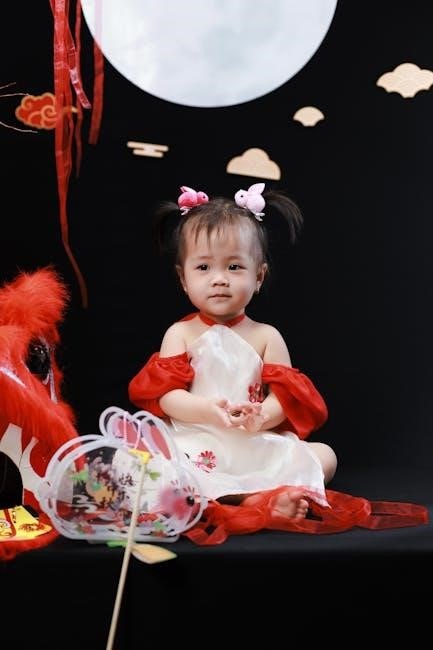Properly dressing your baby according to temperature is crucial for their comfort and health. This guide offers practical advice to help you make informed decisions for your baby’s clothing needs, ensuring they stay comfortable in any weather condition.
Understanding the Importance of Dressing Your Baby According to Temperature
Dressing your baby according to temperature is essential for their comfort and health. Babies struggle to regulate their body heat as effectively as adults, making them more vulnerable to extreme temperatures. Overdressing can lead to overheating, while underdressing may cause chill, both of which can distress your baby and potentially harm their health. Proper clothing helps maintain a stable body temperature, preventing discomfort and promoting healthy development. Additionally, appropriate dressing adapts to seasonal changes, ensuring your baby stays cozy in winter and cool in summer. By understanding how temperature affects your baby, you can make informed choices to keep them safe and comfortable year-round. This guide provides you with the knowledge to dress your baby appropriately for any weather condition.

How to Use This Guide Effectively
This guide is designed to help you dress your baby comfortably and safely in various temperatures. Start by skimming the table of contents to identify relevant sections for your current needs. Pay attention to the seasonal dressing tips and layering advice, as these are key to adapting to changing weather. Refer to the temperature-specific sections for detailed guidance on choosing appropriate clothing. Use the monitoring tips to ensure your baby’s comfort and adjust their outfitting as needed. Remember, every baby is unique, so observe your child’s responses to different environments and adjust your approach accordingly. By following this guide, you’ll gain confidence in keeping your baby comfortable and protected in any weather condition. Let this resource be your go-to for all your baby’s temperature-related clothing needs.
Understanding Baby’s Thermal Needs
Babies have unique thermal needs due to their developing physiology. Their high surface area to volume ratio leads to quick heat loss, and their temperature regulation is still developing. Monitoring and appropriate dressing are crucial for their comfort and health.
How Babies Regulate Body Heat
Babies regulate body heat through a complex process controlled by the hypothalamus, the body’s thermostat. Unlike adults, they lose heat quickly due to their high surface area-to-volume ratio and thin layer of body fat. In warm environments, babies sweat to cool down, while in colder conditions, they shiver to generate heat. However, their sweat glands are immature, making cooling less efficient, and their small muscle mass limits shivering’s effectiveness. Babies also rely on non-shivering thermogenesis, a process where brown fat produces heat without muscle movement. This unique fat, abundant in infants, plays a key role in maintaining body temperature. Understanding these mechanisms helps parents dress their babies appropriately, ensuring comfort and safety in varying temperatures.
Factors Affecting a Baby’s Comfort in Different Temperatures
Several factors influence a baby’s comfort in varying temperatures, including their age, weight, and overall health. Newborns and premature babies are more sensitive to temperature changes due to underdeveloped regulation systems. Humidity, air circulation, and the baby’s activity level also play roles. Additionally, the fit and breathability of clothing, as well as the baby’s individual tolerance to heat or cold, can significantly impact comfort. Skin sensitivity and the ability to stay dry further affect how a baby feels in different conditions. Understanding these factors helps parents make informed decisions about dressing their baby appropriately for the environment, ensuring their little one stays cozy and safe.

Dressing Your Baby by Season
Dressing your baby by season requires adjusting clothing to match changing temperatures and activities. Each season calls for specific fabrics and layering to ensure comfort and safety.
Seasonal Dressing Tips for Babies
Dressing your baby seasonally ensures comfort and safety. In summer, opt for lightweight, breathable fabrics like cotton and avoid overlayering to prevent overheating. Spring and fall require layering with materials such as cotton and merino wool, allowing easy adjustments. Winter calls for thicker fabrics like fleece and wool, paired with accessories like hats and mittens. Always consider indoor versus outdoor temperatures and activity levels. For example, a baby in air-conditioned spaces may need a light sweater, while outdoor play in winter requires bundling up. Monitoring your baby’s environment and their cues helps tailor clothing choices effectively. Seasonal dressing balances protection from the elements with maintaining a comfortable body temperature, promoting overall well-being.

Layering Clothes: A Key to Adjusting to Changing Temperatures
Layering clothes is essential for adapting to fluctuating temperatures and activities. Start with a breathable base layer, such as cotton, to wick away moisture. Add a mid-layer like fleece for warmth, and finish with a waterproof or windproof outer layer for protection. This approach allows easy adjustments as conditions change, ensuring your baby stays comfortable without overheating or chilling. Layering also helps regulate body temperature during transitions, like moving from indoors to outdoors. By using removable layers, you can tailor your baby’s clothing to their environment, promoting flexibility and comfort throughout the day. This method is particularly useful in unpredictable weather or during active play, ensuring your baby’s needs are met seamlessly.
The Role of Fabrics in Maintaining Baby’s Body Temperature
Fabrics play a crucial role in regulating your baby’s body temperature. Natural fibers like cotton and bamboo are breathable, allowing moisture to evaporate and preventing overheating. Synthetic fabrics, such as fleece and polyester, trap warmth, making them ideal for colder conditions; The choice of fabric ensures comfort by balancing insulation and airflow. Lightweight materials are best for warm weather, while thicker, insulating fabrics are suited for cooler environments. Avoid heavy or non-breathable fabrics that can cause discomfort or skin irritation. Selecting the right fabric for the season and activity level helps maintain your baby’s optimal body temperature, ensuring they stay comfortable and healthy year-round.
A Step-by-Step Guide to Dressing Your Baby
Dressing your baby involves assessing the environment, choosing appropriate layers, and ensuring comfort. Start with a base layer, add insulating layers, and finish with a protective outer layer. Always check for signs of overheating or chilling to adjust clothing as needed.

Dressing for Warm Weather (Above 75°F/24°C)
For warm weather, dress your baby in lightweight, breathable fabrics like cotton or linen; Opt for single-layer clothing, such as a onesie or lightweight dress, to prevent overheating. Avoid overdressing, as babies can quickly overheat in high temperatures. Ensure clothing allows for proper airflow to keep your baby cool and comfortable. Hats and light blankets can be used for sun protection but should be removed indoors to avoid overheating.
Monitor your baby’s comfort by checking for signs of sweating or flushed skin. In extremely hot environments, consider using lightweight, breathable blankets or fans to maintain a comfortable temperature. Always ensure your baby has access to plenty of fluids to stay hydrated. Avoid leaving your baby in direct sunlight for extended periods, even if dressed appropriately.
Dressing for Mild Weather (65°F to 75°F/18°C to 24°C)
For mild weather, dress your baby in lightweight, breathable clothing that provides comfort without overheating. Opt for single or light layers, such as a cotton onesie or a lightweight romper, paired with soft pants or leggings. Ensure fabrics are natural and breathable, like cotton or bamboo, to regulate body temperature effectively.
Add a light sweater or cardigan if the temperature dips slightly, but avoid heavy or thick materials. Sleepwear should also be lightweight and made of breathable fabrics to maintain comfort during naps or overnight. Accessorize with a light hat and socks, but avoid overlayering to prevent overheating. Always monitor your baby’s comfort by checking for signs of sweating or flushing, and adjust clothing as needed to ensure they remain cool and cozy.
Dressing for Cool Weather (55°F to 65°F/13°C to 18°C)
For cool weather, dress your baby in layers to maintain warmth without overloading them. Start with a breathable base layer, such as a cotton onesie or leggings, followed by a fleece sweater or light jacket. Add a pair of warm socks and consider a soft hat to prevent heat loss from the head.
Opt for fabrics like cotton, merino wool, or soft fleece, which are warm yet gentle on sensitive skin. If heading outdoors, add a lightweight waterproof jacket or coat for protection against wind or rain. Avoid bulky layers that could restrict movement or cause discomfort.
Check your baby’s comfort by feeling their chest or back; they should feel warm but not sweaty. Adjust layers as needed to keep them cozy without overheating. Sleepwear should also be seasonally appropriate, such as footed pajamas or a warm sleep sack.
Dressing for Cold Weather (Below 55°F/13°C)
For cold weather, prioritize warmth and protection. Start with a snug, breathable base layer, such as a long-sleeve onesie made of merino wool or thermal cotton. Add a thick, insulating mid-layer, like a fleece jacket or sweater, to trap warmth. Finish with a waterproof and windproof outer layer, such as a heavy-duty snowsuit or parka, to shield against harsh conditions.
Don’t forget accessories: a warm hat, scarf, and gloves or mittens to prevent heat loss. Opt for soft, moisture-wicking fabrics to keep skin dry. Ensure shoes or boots are sturdy and waterproof. Indoors, layering can be adjusted, but maintain a cozy sleep environment with warm sleepwear, such as thermal onesies or sleep sacks. Always check your baby’s comfort by feeling their chest or back; they should feel warm but not sweaty.

Monitoring Your Baby’s Comfort

Regularly check your baby’s temperature by feeling their chest or back. Ensure they’re warm but not sweaty, adjusting layers as needed to maintain comfort and prevent overheating.

How to Check if Your Baby is Too Hot or Too Cold
To determine if your baby is too hot or cold, gently feel their chest or back. Avoid touching their hands or feet, as these can be misleading. Look for physical cues: sweating, flushed skin, or overheating indicate they may be too warm, while pale or cool skin suggests they might be chilly. Behavioral changes, such as fussiness or lethargy, can also signal discomfort. Additionally, check for visible signs like damp clothes or shivering. Regularly monitor their environment and adjust layers accordingly to maintain a balanced body temperature.
- Feel your baby’s chest or back for warmth.
- Look for signs of sweating or flushed skin (overheating) or pale skin (underheating).
- Monitor for behavioral changes, such as fussiness or lethargy.
- Adjust clothing layers based on these observations.
Signs of Overheating or Underheating in Babies
Recognizing signs of overheating or underheating in babies is essential for maintaining their comfort and health. Overheating can lead to discomfort, sweating, and flushed skin, while underheating may cause shivering, pale skin, or cool extremities. Look for behavioral cues: a baby who is too hot may appear irritable or restless, while one who is too cold might be unusually still or lethargic. Additionally, check for physical indicators such as rapid breathing (overheating) or a lack of energy (underheating). If you notice these signs, adjust their clothing layers promptly to restore a comfortable temperature balance.
- Overheating: Sweating, flushed skin, irritability, rapid breathing.
- Underheating: Pale skin, shivering, lethargy, cold hands/feet.
Monitoring these signs ensures your baby stays cozy and safe in any weather.

Additional Tips for Dressing Your Baby

Always ensure clothes fit well, avoiding tight garments that restrict movement. Opt for breathable fabrics and consider layers that can be easily added or removed.
- Avoid overheating by checking clothing thickness and room temperature.
- Choose seasonally appropriate fabrics for comfort and temperature regulation.
- Consider your baby’s activity level when selecting outfits.
These tips help maintain your baby’s comfort and safety year-round.
The Importance of Sleepwear and Temperature Regulation
Sleepwear plays a crucial role in maintaining your baby’s comfort and safety during rest. Proper sleepwear helps regulate body temperature, ensuring your baby neither overheats nor feels too cold. Choose breathable fabrics like cotton or bamboo, which allow for airflow and moisture wicking. Avoid heavy or thick materials that can trap heat. Opt for snug-fitting sleepwear to prevent cold spots, but ensure it’s not too tight, as this can restrict movement. Layering is also effective for sleep, with a lightweight onesie under pajamas for cooler nights. Consider the room temperature and adjust sleepwear accordingly to promote a restful environment. By prioritizing appropriate sleepwear, you help your baby sleep soundly and maintain optimal body temperature, supporting their overall well-being.
- Opt for breathable fabrics to prevent overheating.
- Ensure a snug fit without restricting movement.
- Layer sleepwear according to room temperature.
These practices ensure your baby stays comfortable and safe during sleep.
Choosing the Right Accessories for Different Seasons
Accessories play a vital role in enhancing your baby’s comfort and style across different seasons. In warmer months, opt for lightweight hats, breathable socks, and soft sunglasses to protect your baby from the sun. For colder weather, choose warm hats, scarves, and mittens made from soft, insulating materials like wool or fleece. Ensure accessories fit properly to avoid discomfort or restricted movement. Layers like light cardigans or sweaters can add versatility to outfits. Additionally, consider season-specific items like booties for cold weather or lightweight wraps for mild days; Always prioritize breathable fabrics and avoid over-accessorizing to maintain your baby’s comfort. By selecting the right accessories, you can adapt your baby’s outfit to suit any season while keeping them cozy and stylish.
- Warm weather: Lightweight hats, breathable socks, and soft sunglasses.
- Cold weather: Warm hats, scarves, and mittens made from insulating materials.
- Ensure proper fit to prevent discomfort or restricted movement.
- Prioritize breathable fabrics and avoid over-accessorizing.
Dressing your baby according to temperature ensures their comfort and health. By layering, choosing the right fabrics, and adapting to seasonal changes, you can keep your baby cozy and safe year-round.
Key Takeaways for Dressing Your Baby Based on Temperature
To ensure your baby’s comfort and safety, always monitor the temperature and adjust their clothing accordingly. Dress in layers to adapt to changing conditions, especially indoors and outdoors. For temperatures above 75°F (24°C), opt for lightweight, breathable fabrics like cotton. In cooler weather, use thermal layers and ensure extremities like hands and feet are covered. Avoid over-dressing, as it can lead to overheating. Check for signs of discomfort, such as sweating or shivering, and adjust clothing as needed. Remember, a baby’s comfort is key to their health and happiness. By following these guidelines, you can confidently dress your baby for any weather, ensuring they stay cozy and content year-round.